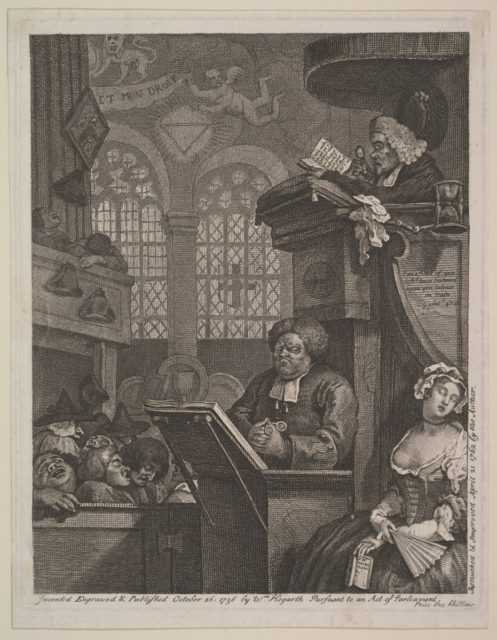William Hogarth (English, b. 1697)
The Sleeping Congregation
Etching and Engraving
26.5″ x 21″
Gift of John A. Welsh, Class of 1959
William Hogarth (b. 1697) was an English painter, printmaker, and satirist renowned for his moralistic paintings and engravings of quotidian life in 18th century London. Over 40 years of printmaking and editorial cartooning, the artist’s burin spared no one, cutting across class lines to moralize at all tiers of English society.
Hogarth’s career began in apprenticeship. Born to a poor family in the Leicester Fields, he pursued trade education early on. Working as an apprentice to a number of engravers, producing trade cards and like items, Hogarth also advanced his interest in fine art alongside other artists through membership in the Rose and Crown Club. In his early 20s, the artist took to engraving on his own and began to produce higher order items – coats of arms and printing plates for book sellers.
As his pictorial skills advanced, the artist began to produce in his own right, observing and sketching life on the London Streets to furnish satirical engravings which he would later copy and sell widely. Most notably, he advanced the concept of the “modern moral subject,” a brand of painting which satirizes the manners and morals of a period’s public, widely and unspecifically. Hogarth’s observations deeply influenced the history of satire in art and the work and consideration of artists like Honare Daumier, George Grosz and David Hockney. The Sleeping Congregation embodies that social interest and involves a range of English archetypes. It’s one of 11 equally comedic prints by the artist in our collection.
Hogarth’s satire was unique at the time for representing of a range of subjects and goings-on. The clergyman – foregrounded by a long-expired hourglass – lulls his parish into total torpor while a small group of witches observe the service. His clerk, awake but uninterested, shoots a sidelong glance at the exposed chest of a nearby young women. Each element carries unique moral and social observations, diving into the subjects of paganism, organized religion, and the male gaze concurrently.
I’m drawn to that diversity of observation particularly. Much of the social satire I’m familiar with focuses on a single subject or theme in order to critique a particular practice, observing with a directed eye. Hogarth’s concern is wider, multifaceted and more public. Plus, it’s funny and certainly enough to garner a smile and a laugh!
-Sebi Sola-Sole ’21

